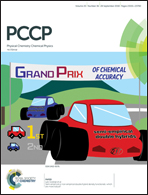Model – free approach to quadrupole spin relaxation in solid 209Bi-aryl compounds
Abstract
Nuclear Quadrupole Resonance (NQR) experiments were performed for deuterated and non-deuterated triphenylbismuth (BiPh3) to inquire into 209Bi relaxation mechanisms. The studies are motivated by the idea of exploiting Quadrupole Relaxation Enhancement (QRE) as a novel contrast mechanism for Magnetic Resonance Imaging. From this perspective relaxation features of nuclei possessing quadrupole moment (quadrupole nuclei) are of primary importance for the contrast effect. Spin–spin relaxation rates associated with the NQR lines were described in terms of the Redfield relaxation theory assuming that the relaxation is caused by fluctuations of the electric field gradient tensor at the position of the quadrupole nucleus that are described by an exponential correlation function. The description referred to as a model-free approach is an analogy of the description used for paramagnetic contrast agents. It was demonstrated that for the deuterated compound this approach captures the essential features of 209Bi relaxation, but it should not be applied for non-deuterated compounds as dipolar interactions between neighbouring protons and the quadrupole nucleus considerably contribute to the relaxation of the last one. Thus, the relaxation scenario for species containing quadrupole nuclei is fundamentally different than for paramagnetic contrast agents and this fact has to be taken into account when predicting contrast effects based on QRE.



 Please wait while we load your content...
Please wait while we load your content...